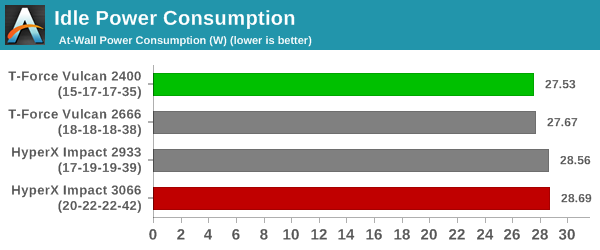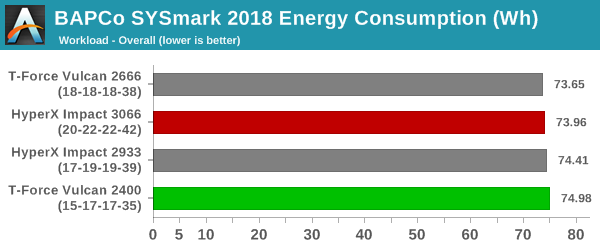Memory Frequency Scaling in SFF Systems: An Investigation with SO-DIMMs and Coffee Lake
by Ganesh T S on November 28, 2018 8:00 AM ESTFinal Words
Improvements in memory bandwidth and reductions in latency are the performance benefits provided by the usage of high-performance SO-DIMM kits. In the previous pages, we looked at the performance of four different SO-DIMM configurations in a SFF desktop PC. Power / energy consumption is one of the last remaining aspects to consider.
In addition to performance, idle power consumption is also an important metric – particularly for usage in battery-constrained systems such as workstation notebooks. The higher the DRAM operating frequency, the greater the power consumption. Some high-frequency kits use 1.35V (instead of the 1.2V standard), which tends to drive up the power consumption further. Fortunately, all our tested configurations had SO-DIMMs that operated at 1.2V.
To get a full view of the impact of different memory kits on this aspect, we monitored the power consumed at the wall by the ASRock DeskMini Z370 GTX with an idle desktop and averaged it over a duration of 1 hour.

As expected, the higher-frequency operating points consumer more power, but not by a huge margin. While considering the above graph, it is also helpful to keep in mind the energy consumption for typical workloads. Kits that help get work done faster may consume less energy compared to the kits that consume less power even during operation.

Coming to the business end of the article, it is clear that the choice of memory is dictated by the expected workloads. For most common workloads, the differences between DDR4-2400 and DDR4-3066 are minimal. However, there are cases where the memory characteristics can play a significant role - 7-Zip compression is a real-world example where the kits with lower latencies deliver better compression rates.
For the average user who keeps the system idle most of the time, it is probably better to save money and have lower idle power in the long run. On the other hand, power users who keep their systems busy may want to opt for kits that deliver low latencies (and, in the case of some workloads, just higher speeds).
| DRAM Options for the ASRock DeskMini GTX (Z370) | |||
| Memory Kit | Tested Frequency (MT/s) |
Tested Timing (tCL-tRCD-tRP-tRAS-tRFC) |
Price (USD) |
| Kingston HyperX Impact HX432S20IB2K2/16 |
3066 | 20-22-22-42-560 | $168 |
| 2933 | 17-19-19-39-514 | ||
| Team Group T-Force Vulcan TLRD416G2666HC18FDC-S01 |
2666 | 18-18-18-38-467 | $130 |
| Team Group T-Force Vulcan TLRD416G2400HC15BDC-S01 |
2400 | 15-17-17-35-421 | $130 |
Our tests have also shown that a higher speed-grade kit is not necessarily better – the HyperX Impact DDR4 operating at 2933 MT/s has the best latency numbers. It edges out the same kit operating at 3066 MT/s with different timing parameters in almost all of the benchmarks. Conversely, the Team Group T-Force Vulcan SO-DIMMs offer good value for money and can boast of better idle power characteristics.











25 Comments
View All Comments
BedfordTim - Wednesday, November 28, 2018 - link
It would have been interesting to see some bargain basement memory in the comparison. Is there a specification below which we start to see a difference?goatfajitas - Wednesday, November 28, 2018 - link
I dunno, I think it gets the job done. The takeaway is the same as it has been for a decade... Higher bandwidth memory with higher latency provides very little actual performance improvements.qlum - Wednesday, November 28, 2018 - link
To add some qualifiers to what you said:In regards to cpu performance
on intel's core achitecture
IGP performance, AMD, certain memory limited workloads tell a different story.
goatfajitas - Wednesday, November 28, 2018 - link
"on intel's core achitecture"Agreed.
Flunk - Wednesday, November 28, 2018 - link
No, not really. The slowest and faster RAM here aren't that far off. What it really tells us is that minimal increases in RAM performance can bring noticeable performance improvements but only in memory-heavy applications. Which is pretty much exactly what you'd expect.goatfajitas - Wednesday, November 28, 2018 - link
"No, not really. The slowest and faster RAM here aren't that far off."That is what I said. Barely noticeable even in synthetic benchmarks.
BedfordTim - Wednesday, November 28, 2018 - link
There is a difference in two memory heavy applications. The RAM drive shows a ~20% benefit and one of the image processing benchmarks shows ~10% benefit.There will be a tiny number of people doing very specific applications who might notice the difference.
peterfares - Wednesday, November 28, 2018 - link
Not sure what other games it applies to but in Overwatch the RAM speed actually has a pretty significant impact on FPS when you start going very high FPS.https://www.reddit.com/r/Overwatch/comments/9srhx5...
Not sure what what speed the benefits stop, but improvements were still easily seen at 3200MHz.
Death666Angel - Wednesday, November 28, 2018 - link
It just seems a bit weird to test those speeds. G.Skill RipJaws SoDIMM DDR4-3200 CL18-18-18-43 are available in 8GB form for the same price as regular DDR4-3200 RAM and the 16GB variant is only slight more expensive (would be 5th in the price ranking with regular DDR4-3200 RAM). Is that just a weird German price thing? I was even considering buying them with an adapter just so I can have some more potential usability for the future. :Ddeil - Wednesday, November 28, 2018 - link
IMHO small things that does not even make the cpu leave lower power state happens faster, page loading, folder browsing etc...might be just bias or simple "better timings" that was also the case for me. Still I feel something different in day-to-day stuff.